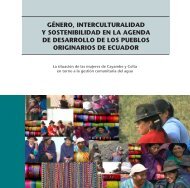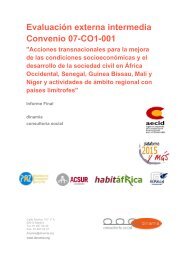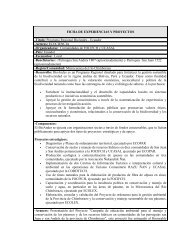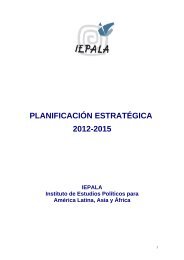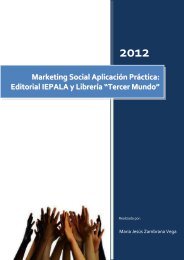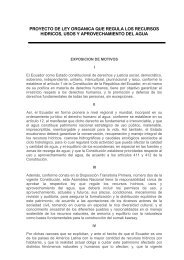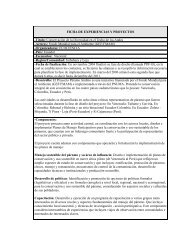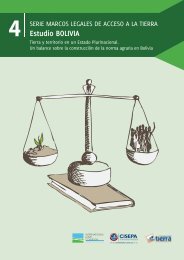Decentralization in Sierra Leone - Research for Development
Decentralization in Sierra Leone - Research for Development
Decentralization in Sierra Leone - Research for Development
You also want an ePaper? Increase the reach of your titles
YUMPU automatically turns print PDFs into web optimized ePapers that Google loves.
<strong>Decentralization</strong> <strong>in</strong> <strong>Sierra</strong> <strong>Leone</strong>The rollout of the programme was coord<strong>in</strong>ated by the World Bank’s Institutional Re<strong>for</strong>m andCapacity Build<strong>in</strong>g Project (IRCBP) through management units located <strong>in</strong> l<strong>in</strong>e m<strong>in</strong>istries.Fiscal decentralization was coord<strong>in</strong>ated by the Local Government F<strong>in</strong>ance Department,(LGFD) located <strong>in</strong> the M<strong>in</strong>istry of F<strong>in</strong>ance, while adm<strong>in</strong>istrative decentralization wascoord<strong>in</strong>ated through the <strong>Decentralization</strong> Secretariat (DecSec), located <strong>in</strong> the M<strong>in</strong>istry ofLocal Government 11 . Both units were staffed by <strong>Sierra</strong> <strong>Leone</strong>an professionals on consultancycontracts and the orig<strong>in</strong>al plan was that they would be ma<strong>in</strong>streamed <strong>in</strong>to their parent l<strong>in</strong>em<strong>in</strong>istries when the project was wound up. The IRCBP was orig<strong>in</strong>ally set to run from 2004 to2009, but additional fund<strong>in</strong>g from the European Union (EU) and DFID from 2006 onwardspermitted an extension until June 2011.Seven years on from the <strong>in</strong>augural local council elections, <strong>Sierra</strong> <strong>Leone</strong> has a fully functionaltier of town and district councils, a new and well-regulated system of fiscal transfers fromcentral to local government, much <strong>in</strong>creased <strong>in</strong>vestment <strong>in</strong> local services, regular productionof participatory development plans, and a comprehensive monitor<strong>in</strong>g system (CLoGPAS)reward<strong>in</strong>g the best per<strong>for</strong>m<strong>in</strong>g councils with additional development grants. Some councilsalso have new office build<strong>in</strong>gs and chambers. The change of government <strong>in</strong> October 2007brought no immediate changes to the programme; <strong>in</strong>com<strong>in</strong>g President Ernest Bai Koromapledged <strong>in</strong> his <strong>in</strong>augural address to Parliament that his adm<strong>in</strong>istration would “strengthen localgovernment per<strong>for</strong>mance through enhanced decentralization and rural development”. Theprogramme passed another milestone <strong>in</strong> May 2008 when a second round of local councilelections was successfully completed.The Compromises of the Local Government ActIn spite of the successful rollout of the decentralization programme, it is still fac<strong>in</strong>g manychallenges. In particular, the LGA of 2004 represents a compromise between different visionsof decentralization. On the one hand, the Kabbah government viewed local councils first and<strong>for</strong>emost as development agencies. It had no <strong>in</strong>tention of remov<strong>in</strong>g the hierarchy ofparamount, section and village chiefs from their colonially-wrought role as the state’sprimary agents <strong>for</strong> ma<strong>in</strong>ta<strong>in</strong><strong>in</strong>g social order <strong>in</strong> rural areas. <strong>Sierra</strong> <strong>Leone</strong>’s Director of LocalGovernment made this view clear <strong>in</strong> an <strong>in</strong>terview with the DFID Drivers of Change team <strong>in</strong>2005. “The local councils are <strong>for</strong> development”, he announced, “and the chiefdoms are <strong>for</strong>law and order”. This statement recapitulates the relationship between district councils and thechiefdoms <strong>in</strong> the late colonial era. The first district councils, <strong>in</strong>itially <strong>for</strong>ums <strong>for</strong> chiefs, were<strong>in</strong>corporated <strong>in</strong> 1950 as the old Colony and Protectorate of <strong>Sierra</strong> <strong>Leone</strong> underwentadm<strong>in</strong>istrative unification <strong>in</strong> preparation <strong>for</strong> de-colonization. The economic development ofProtectorate had long been lagg<strong>in</strong>g beh<strong>in</strong>d that of the Colony and the British adm<strong>in</strong>istrationdecided that it should have priority access to the colonial development funds that werecom<strong>in</strong>g back on stream after the Second World War. The ma<strong>in</strong> function of a district council,accord<strong>in</strong>g to the orig<strong>in</strong>al District Councils Ord<strong>in</strong>ance (no. 17 of 1950), was to “promote thedevelopment of the District and the Welfare of its people, with the funds at its disposal”. Thedistrict and town councils were <strong>in</strong>serted between central government and the chiefdoms andtheir primary activity was development plann<strong>in</strong>g and project implementation. Servicefunctions were added a few years later (Davidson, 1953; Zwanikken et al, 1994).The Kabbah government had survived the civil war with little de facto authority outside thecapital, so it is not hard to see why it was attracted to the idea of channell<strong>in</strong>g post-war11 The official names of these m<strong>in</strong>istries have changed over the last decade and simplified versions areused hereFanthorpe Consultancy Ltd Page 53




